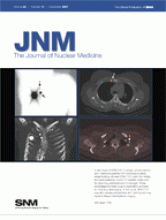Table of Contents
Cover image

A pilot study of SPECT/CT in breast cancer patients and melanoma patients with inconclusive planar image findings showed SPECT/CT useful for finding the exact anatomic location of sentinel nodes and for detecting additional sites of drainage. These advantages facilitate surgical exploration and lead to more accurate staging. In the future, SPECT/CT may also obviate preoperative skin marking and may replace delayed lateral planar imaging.
See page 1756.



